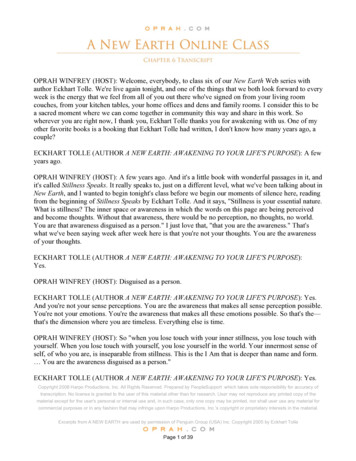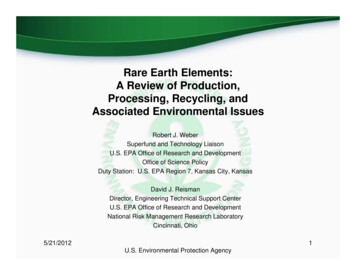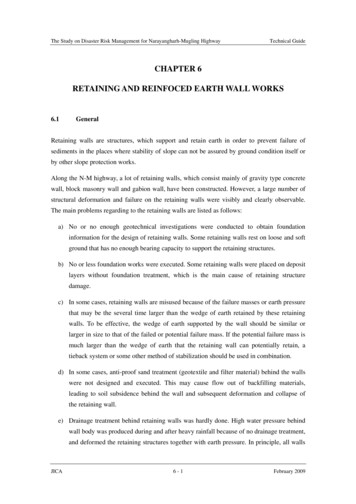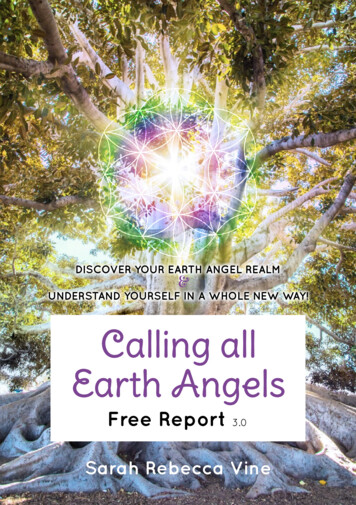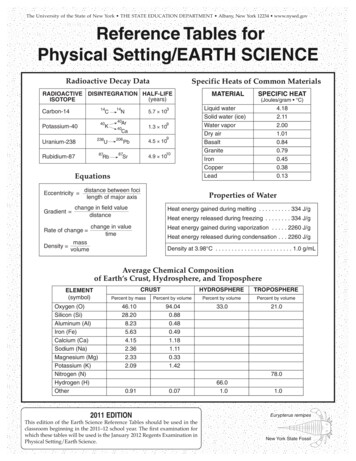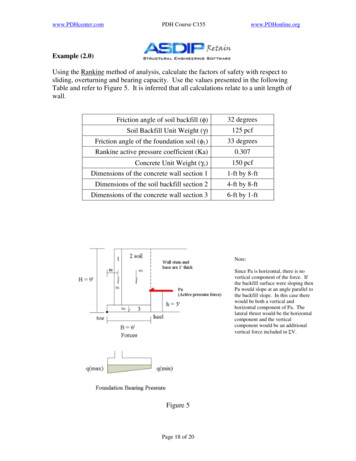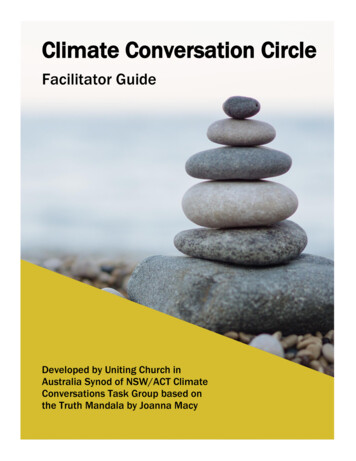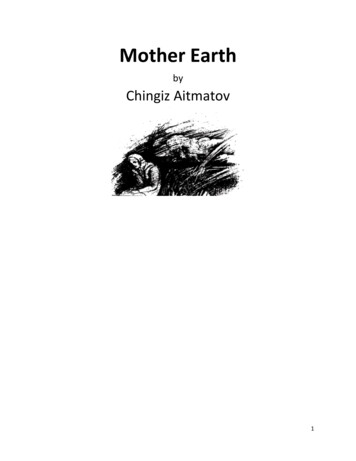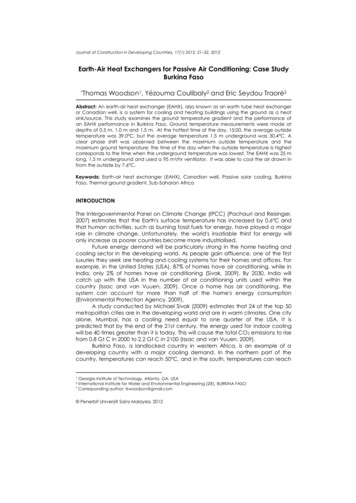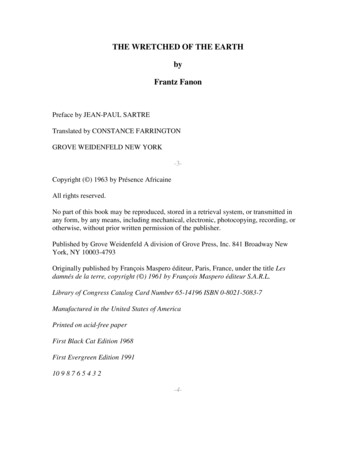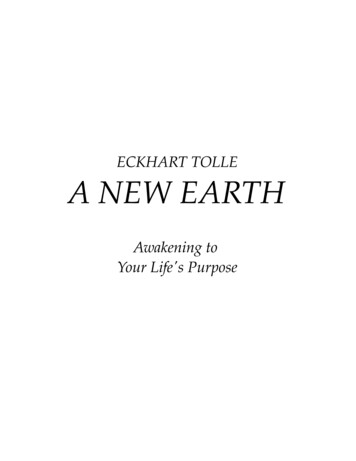
Transcription
ECKHART TOLLEA NEW EARTHAwakening toYour Life's Purpose
CONTENTSChapter OneThe Flowering of Human Consciousness – 6Evocation.6The Purpose of This Book.8Our Inherited Dysfunction.10The Arising New consciousness.12Spirituality and Religion.14The Urgency of Transformation.16A New Heaven and a new Earth.18Chapter TwoEgo: The Current State of Humanity – 19The Illusory Self.20The Voice in the Head.22Content and Structure of the Ego.24Identification with Things.25The Lost Ring.26The Illusion of Ownership.29Wanting: The Need for More.31Identification with the Body.33Feeling the Inner Body.34Forgetfulness of Being.35From Descartes's Error to Sartre's Insight.36The Peace that Passes All Understanding.37Chapter ThreeThe Core of Ego – 39Complaining and Resentment.40Reactivity and Grievances.42Being Right, Making Wrong.43In Defense of an Illusion.44Truth: Relative or Absolute?.45The Ego Is Not Personal.46War Is a Mind set.48Do You Want Peace or Drama? .49
Beyond Ego: Your True Identity .50All Structures are Unstable.51The Ego's Need to Feel Superior.52Ego and Fame.52Chapter FourRole Playing: The Many Faces of the Ego 54Villain, Victim, Lover.55Letting Go of Self Definitions.56Pre established Roles.57Temporary Roles.58The Monk with Sweaty Palms.59Happiness as a Role Vs. True Happiness.59Parenthood: Role or Function? .60Conscious Suffering.63Conscious Parenting.64Recognizing Your Child.65Giving Up Role playing.66The Pathological Ego.68The Background Unhappiness.70The Secret of Happiness.71Pathological Forms of Ego.73Work – with and Without Ego.75The Ego in Illness.77The Collective Ego.77Incontrovertible Proof of Immortality.79Chapter FiveThe Pain Body 80The Birth of Emotion.81Emotions and the Ego.83The Duck with a Human Mind.85Carrying the Past.85Individual and Collective.87How the Pain Body Renews Itself.89How the Pain body Feeds on Your Thoughts.90How the pain Body Feeds on Drama.91
Dense Pain bodies.93Entertainment, the Media, and the Pain Body.94The Collective Female Pain body.95National and Racial Pain bodies.97Chapter SixBreaking Free 99Presence.100The Return of the Pain Body.102The Pain body in Children.103Unhappiness.105Breaking Identification with the Pain body.106“Triggers”.108The Pain Body as an Awakener.110Breaking Free of the Pain Body.112Chapter SevenFinding Who You Truly Are 113Who you Think you are.114Abundance.116Knowing Yourself and Knowing About Yourself.117Chaos and Higher Order.118Good and Bad.119Not Minding What Happens.120Is That So?.121The Ego and the Present Moment .122The Paradox of Time.124Eliminating Time.125The Dreamer and the Dream.127Going Beyond Limitation.128The Joy of Being.130Allowing the Diminishment of the Ego.130As Without, So Within.132Chapter EightThe Discovery of Inner Space 135Object Consciousness and Space Consciousness.137
Falling Below and Rising Above Thought.138Television.139Recognizing Inner Space.141Can You Hear the Mountain Stream? .143Right Action.144Perceiving Without Naming.144Who Is the Experiencer? .146The Breath.147Addictions.149Inner Body Awareness.150Inner and Outer Space.151Noticing the Gaps.153Lose yourself to Find Yourself.153Stillness.154Chapter NineYour Inner Purpose 155Awakening.156A Dialogue on Inner Purpose.158Chapter TenA New Earth 167A Brief History of Your Life.169Awakening and the Return Movement.170Awakening and the Outgoing Movement.172Consciousness.174Awakened Doing.175The Three Modalities of Awakened The Frequency holders.183The New Earth Is No Utopia.184Notes.186About the Author.189
CHAPTER ONETHE FLOWERING OF HUMAN CONSCIOUSNESSEVOCATIONEarth, 114 million years ago, one morning just after sunrise: The first flowerever to appear on the planet opens up to receive the rays of the sun. Prior tothis momentous event that heralds an evolutionary transformation in the lifeof plants, the planet had already been covered in vegetation for millions ofyears. The first flower probably did not survive for long, and flowers musthave remained rare and isolated phenomena, since conditions were mostlikely not yet favorable for a widespread flowering to occur. One day,however, a critical threshold was reached, and suddenly there would havebeen an explosion of color and scent all over the planet – if a perceivingconsciousness had been there to witness it.Much later, those delicate and fragrant beings we call flowers wouldcome to play an essential part in the evolution of consciousness of anotherspecies. Humans would increasingly be drawn to and fascinated by them. Asthe consciousness of human beings developed, flowers were most likely thefirst thing they came to value that had no utilitarian purpose for them, that isto say, was not linked in some way to survival. They provided inspiration tocountless artists, poets, and mystics. Jesus tells us to contemplate the flowersand learn from then how to live. The Buddha is said to have given a “silentsermon” once during which he held up a flower and gazed at it. After awhile, one of those present, a monk called Mahakasyapa, began to smile. Heis said to have been the only one who had understood the sermon. Accordingto legend, that smile (that is to say, realization) was handed down by twenty eight successive masters and much later became the origin of Zen.Seeing beauty in a flower could awaken humans, however briefly, tothe beauty that is an essential part of their own innermost being, their truenature. The first recognition of beauty was one of the most significant eventsin the evolution of human consciousness. The feelings of joy and love areintrinsically connected to that recognition. Without our fully realizing it,flowers would become for us an expression in form of that which is mosthigh, most sacred, and ultimately formless within ourselves. Flowers, morefleeting, more ethereal and more delicate than the plants out of which theyemerged, would become like messengers from another realm, like a bridge
between the world of physical forms and the formless. They not only had ascent that was delicate and pleasing to humans, but also brought a fragrancefrom the realm of spirit. Using the word “enlightenment” in a wider sensethan the conventionally accepted one, we could look upon flowers as theenlightenment of plants.Any life form in any realm – mineral, vegetable, animal, or human –can be said to undergo “enlightenment.” It is, however, an extremely rareoccurrence since it is more than an evolutionary progression: It also impliesa discontinuity in its development, a leap to an entirely different level ofBeing and, most important, a lessening of materiality.What could be heavier and more impenetrable than a rock, the densestof all forms? And yet some rocks undergo a change in their molecularstructure, turn into crystals, and so become transparent to the light. Somecarbons, under inconceivable heat and pressure, turn into diamonds, andsome heavy minerals into other precious stones.Most crawling reptilians, the most earthbound of all creatures, haveremained unchanged for millions of years. Some, however, grew feathers andwings and turned into birds, thus defying the force of gravity that had heldthem for so long. They didn’t become better at crawling or walking, buttranscended crawling and walking entirely.Since time immemorial, flowers, crystals, precious stones, and birdshave held special significance for the human spirit. Like all life forms, theyare, of course, temporary manifestations of the underlying one Life, oneConsciousness. Their special significance and the reason why humans feelsuch fascination for and affinity with them can be attributed to their etherealquality.Once there is a certain degree of presence, of still and alert attentionin human beings’ perceptions, they can sense the divine life essence, the oneindwelling consciousness or spirit in every creature, every life form,recognize it as one with their own essence and so love it as themselves. Untilthis happens, however, most humans see only the outer forms, unaware of theinner essence, just as they are unaware of their own essence and identify onlywith their own physical and psychological form.In the case of a flower, a crystal, precious stone, or bird, however, evensomeone with little or no Presence can occasionally sense that there is morethan the mere physical existence of that form, without knowing that this isthe reason why he or she is drawn toward it, feels an affinity with it. Becauseof its ethereal nature, its form obscures the indwelling spirit to a lesser
degree than is the case with other life forms. The exception to this are allnewborn life forms – babies, puppies, kittens, lambs, and so on. They arefragile, delicate, not yet firmly established in materiality. An innocence, asweetness and beauty that are not of this world still shine through them.They delight even relatively insensitive humans.So when you are alert and contemplate a flower, crystal, or birdwithout naming it mentally, it becomes a window for you into the formless.There is an inner opening, however slight, into the realm of spirit. This iswhy these three “en lightened” life forms have played such an important partin the evolution of human consciousness since ancient times; why, forexample, the jewel in the lotus flower is a central symbol of Buddhism and awhite bird, the dove, signifies the Holy Spirit in Christianity. They have beenpreparing the ground for a more profound shift in planetary consciousnessthat is destined to take place in the human species. This is the spiritualawakening that we are beginning to witness now.THE PURPOSE OF THIS BOOKIs humanity ready for a transformation of consciousness, an innerflowering so radical and profound that compared to it the flowering ofplants, no matter how beautiful, is only a pale reflection? Can human beingslose the density of their conditioned mind structures and become likecrystals or precious stones, so to speak, transparent to the light ofconsciousness? Can they defy the gravitational pull of materialism andmateriality and rise above identification with form that keeps the ego inplace and condemns them to imprisonment within their own personality?The possibility of such a transformation has been the central messageof the great wisdom teachings of humankind. The messengers – Buddha,Jesus, and others, not all of them known – were humanity’s early flowers.They were precursors, rare and precious beings. A widespread flowering wasnot yet possible at that time, and their message became largelymisunderstood and often greatly distorted. It certainly did not transformhuman behavior, except in a small minority of people.Is humanity more ready now than at the time of those early teachers?Why should this be so? What can you do, if anything, to bring about oraccelerate this inner shift? What is it that characterizes the old egoic state ofconsciousness, and by what signs is the new emerging consciousnessrecognized? These and other essential questions will be addressed in thisbook. More important, this book itself is a transformational device that has
come out of the arising new consciousness. The ideas and conceptspresented here may be important, but they are secondary. They are no morethan signposts pointing toward awakening. As you read, a shift takes placewithin you.This book’s main purpose is not to add new information or beliefs toyour mind or to try to convince you of anything, but to bring about a shift inconsciousness; that is to say, to awaken. In that sense, this book is not“interesting”. Interesting means you can keep your distance, play aroundwith ideas and concepts in your mind, agree or disagree. This book is aboutyou. It will change your state of consciousness or it will be meaningless. Itcan only awaken those who are ready. Not everyone is ready yet, but manyare, and with each person who awakens, the momentum in the collectiveconsciousness grows, and it becomes easier for others. If you don’t knowwhat awakening means, read on. Only by awakening can you know the truemeaning of that word. A glimpse is enough to initiate the awakening process,which is irreversible. For some, that glimpse will come while reading thisbook. For many others who may not even have realized it, the process hasalready begun. This book will help them recognize it. For some, it may havebegun through loss or suffering; for others, through coming into contact witha spiritual teacher or teaching, through reading The Power of Now or someother spiritually alive and therefore transformational book – or anycombination of the above. If the awakening process has begun in you , thereading of this book will accelerate and intensify it.An essential part of the awakening is the recognition of theunawakened you, the ego as it thinks, speaks and acts, as well as therecognition of the collectively conditioned mental processes that perpetuatethe unawakened state. That is why this book shows the main aspects of theego and how they operate in the individual as well as in the collective. Thisis important for two related reasons: The first is that unless you know thebasic mechanics behind the workings of the ego, you won’t recognize it, andit will trick you into identifying with it again and again. This means it takesyou over, an impostor pretending to be you. The second reason is that the actof recognition itself is one of the ways in which awakening happens. Whenyou recognize the unconsciousness in you, that which makes the recognitionpossible is the arising consciousness, is awakening. You cannot fight againstthe ego and win, just as you cannot fight against darkness. The light ofconsciousness is all that is necessary. You are that light.
OUR INHERITED DYSFUNCTIONIf we look more deeply into humanity’s ancient religions and spiritualtraditions, we will find that underneath the many surface differences thereare two core insights that most of them agree on. The words they use todescribe those insights differ, yet they all point to a twofold fundamentaltruth. The first part of this truth is the realization that the “normal” state ofmind of most human beings contains a strong element of what we might calldysfunction or even madness. Certain teachings at the heart of Hinduismperhaps come closest to seeing this dysfunction as a form of collectivemental illness. They call it maya, the veil of delusion. Ramana Maharshi,one of the greatest Indian sages, bluntly states: “The mind is maya.”Buddhism uses different terms. According to the Buddha, the humanmind in its normal state generates dukkha, which can be translated assuffering, unsatisfactoriness, or just plain misery. He sees it as acharacteristic of the human condition. Wherever you go, whatever you do,says the Buddha, you will encounter dukkha, and it will manifest in everysituation sooner or later.According to Christian teachings, the normal collective state ofhumanity is one of “original sin.” Sin is a word that has been greatlymisunderstood and misinterpreted. Literally translated from the ancientGreek in which the New Testament was written, to sin means to miss themark, as an archer who misses the target, so to sin means to miss the point ofhuman existence. It means to live unskillfully, blindly, and thus to suffer andcause suffering. Again, the term, stripped of its cultural baggage andmisinterpretations, points to the dysfunction inherent in the humancondition.The achievements of humanity are impressive and undeniable. Wehave created sublime works of music, literature, painting, architecture, andsculpture. More recently, science and technology have brought about radicalchanges in the way we live and have enabled us to do and create things thatwould have been considered miraculous even two hundred years ago. Nodoubt: The human mind is highly intelligent. Yet its very intelligence istainted by madness. Science and technology have magnified the destructiveimpact that the dysfunction of the human mind has upon the planet, otherlife forms, and upon humans themselves. That is why the history of thetwentieth century is where that dysfunction, that collective insanity, can bemost clearly recognized. A further factor is that this dysfunction is actuallyintensifying and accelerating.
The First World War broke out in 1914. Destructive and cruel wars,motivated by fear, greed, and the desire for power, had been commonoccurrences throughout human history, as had slavery, torture, andwidespread violence inflicted for religious and ideological reasons. Humanssuffered more at the hands of each other than through natural disasters. Bythe year 1914, however, the highly intelligent human mind had invented notonly the internal combustion engine, but also bombs, machine guns,submarines, flame throwers, and poison gas. Intelligence in the service ofmadness! In static trench warfare in France and Belgium, millions of menperished to gain a few miles of mud. When the war was over in 1918, thesurvivors look in horror and incomprehension upon the devastation leftbehind: ten million human beings killed and many more maimed ordisfigured. Never before had human madness been so destructive in itseffect, so clearly visible. Little did they know that this was only thebeginning.By the end of the century, the number of people who died a violentdeath at the hand of their fellow humans would rise to more than onehundred million. They died not only through wars between nations, but alsothrough mass exterminations and genocide, such as the murder of twentymillion “class enemies, spies, and traitors” in the Soviet Union under Stalinor the unspeakable horrors of the Holocaust in Nazi Germany. They alsodied in countless smaller internal conflicts, such as the Spanish civil war orduring the Khmer Rouge regime in Cambodia when a quarter of thatcountry’s population was murdered.We only need to watch the daily news on television to realize that themadness has not abated, that is continuing into the twenty first century.Another aspect of the collective dysfunction of the human mind is theunprecedented violence that humans are inflicting on other life forms andthe planet itself – the destruction of oxygen producing forests and other plantand animal life; ill treatment of animals in factory farms; and poisoning ofrivers, oceans, and air. Driven by greed, ignorant of their connectedness tothe whole, humans persist in behavior that, if continued unchecked, can onlyresult in their own destruction.The collective manifestations of the insanity that lies at the heart ofthe human condition constitute the greater part of human history. It is to alarge extent a history of madness. If the history of humanity were the clinicalcase history of a single human being, the diagnosis would have to be:chronic paranoid delusions, a pathological propensity to commit murder and
acts of extreme violence and cruelty against his perceived “enemies” – hisown unconsciousness projected outward. Criminally insane, with a few brieflucid intervals.Fear, greed, and the desire for power are the psychological motivatingforces not only behind warfare and violence between nations, tribes,religions, and ideologies, but also the cause of incessant conflict in personalrelationships. They bring about a distortion in your perception of otherpeople and yourself. Through them, you misinterpret every situation, leadingto misguided action designed to rid you of fear and satisfy your need formore, a bottomless hole that can never be filled.It is important to realize, however, that fear, greed, and the desire forpower are not the dysfunction that we are speaking of but are themselvescreated by the dysfunction which is a deep seated collective delusion thatlies within the mind of each human being. A number of spiritual teachingstell us to let go of fear and desire. But those spiritual practices are usuallyunsuccessful. They haven’t gone to the root of the dysfunction. Fear, greed,and desire for power are not the ultimate causal factors. Trying to become agood or better human being sounds like a commendable and high mindedthing to do, yet it is an endeavor you cannot ultimately succeed in unlessthere is a shift in consciousness. This is because it is still part of the samedysfunction, a more subtle and rarefied form of self enhancement, of desirefor more and a strengthening of one’s conceptual identity, one’s self image.You do not become good by trying to be good, but by finding the goodnessthat is already within you, and allowing that goodness to emerge. But it canonly emerge if something fundamental changes in your state ofconsciousness.The history of Communism, originally inspired by noble ideals,clearly illustrates what happens when people attempt to change externalreality – create a new earth – without any prior change in their inner reality,their state of consciousness. They make plans without taking into accountthe blueprint for dysfunction that every human being carries within: the ego.THE ARISING NEW CONSCIOUSNESSMost ancient religions and spiritual traditions share the commoninsight – that our “normal” state of mind is marred by a fundamental defect.However, out of this insight into the nature of the human condition – we maycall it the bad news – arises a second insight: the good news of thepossibility of a radical transformation of human consciousness. In Hindu
teachings (and sometimes in Buddhism also), this transformation is calledenlightenment. In the teachings of Jesus, it is salvation, and in Buddhism, itis the end of suffering. Libe
degree than is the case with other life forms. The exception to this are all newborn life forms – babies, puppies, kittens, lambs, and so on.
